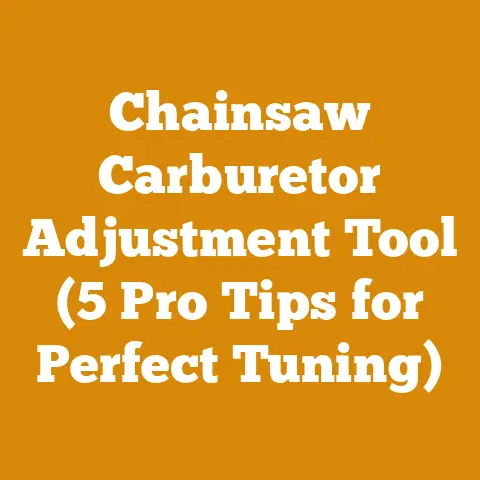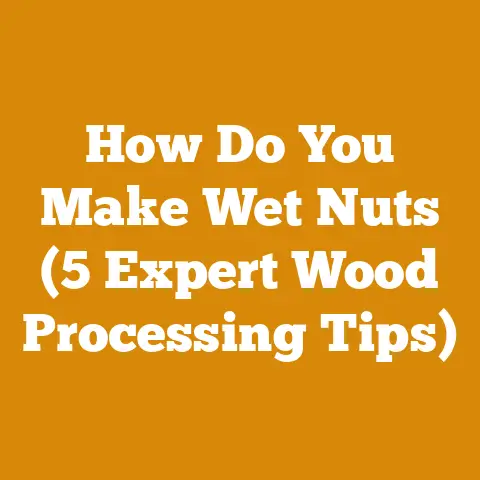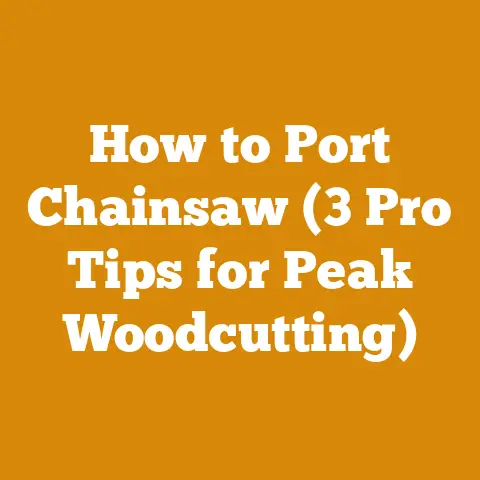Pressure Washer Excell 2600 PSI: Top Pump Swaps (5 Pro Tips)
Ever felt like your pressure washer, the unsung hero of spring cleaning and grime-blasting, is more of a pressure whimper? You pull the trigger, anticipating that satisfying whoosh of power, only to be met with a dribble that wouldn’t even intimidate a muddy garden gnome? If you own an Excell 2600 PSI pressure washer and this scenario sounds familiar, chances are your pump is on its last legs.
Now, before you resign yourself to scrubbing everything by hand (shudder!), I’m here to tell you that there’s hope. Swapping out the pump on your Excell 2600 PSI is a surprisingly achievable DIY project. And I’m not just talking about slapping any old pump on there. I’m going to walk you through finding the right pump, the one that’ll breathe new life into your pressure washer and have you tackling those tough cleaning jobs with gusto.
This isn’t just about replacing a part; it’s about understanding the heart of your machine and making informed decisions that will save you time, money, and a whole lot of frustration. I’ve spent years tinkering with small engines and power equipment, and I’ve learned a thing or two about what works and what doesn’t. So, grab your toolbox, and let’s dive in.
Pressure Washer Excell 2600 PSI: Top Pump Swaps (5 Pro Tips)
Understanding Your Excell 2600 PSI Pressure Washer
Before we even think about swapping pumps, we need to understand what we’re working with. The Excell 2600 PSI pressure washer is a popular model known for its relatively compact size and decent power for residential use. However, like any machine, it has its limitations.
- PSI (Pounds per Square Inch): This is the measure of water pressure. The Excell 2600 PSI is rated, as you guessed, for 2600 PSI. This means it can deliver water with that much force per square inch.
- GPM (Gallons per Minute): This measures the volume of water flow. A typical Excell 2600 PSI will deliver around 2.3 GPM.
- Engine: Most Excell 2600 PSI models are powered by a small gasoline engine, typically around 160cc. This engine drives the pump.
- Pump Type: The pump is usually an axial cam pump. These pumps are relatively inexpensive to manufacture and offer a decent lifespan for residential use, but they are often the first component to fail.
Why Replace the Pump?
The pump is the heart of your pressure washer. It’s responsible for taking in water and pressurizing it. Over time, the pump can wear down due to several factors:
- Hard Water: Mineral deposits can build up inside the pump, reducing its efficiency and eventually causing it to fail. I’ve seen pumps completely clogged with calcium and lime scale, especially in areas with very hard water.
- Lack of Maintenance: Failing to properly winterize your pressure washer or neglecting to change the pump oil can significantly shorten its lifespan.
- Overuse: Pushing the pump beyond its limits can cause premature wear and tear.
- Freezing Temperatures: Water expands when it freezes, and this expansion can crack the pump housing or damage internal components. I once left my pressure washer outside during an unexpected cold snap. The next time I tried to use it, the pump was completely seized. Lesson learned!
When the pump fails, you’ll notice symptoms like:
- Reduced Pressure: The pressure washer won’t deliver the same amount of power as it used to.
- Pulsating Pressure: The pressure will fluctuate erratically.
- Leaks: Water will leak from the pump housing.
- No Pressure: The pump won’t deliver any pressure at all.
Pro Tip #1: Identifying the Correct Replacement Pump
This is arguably the most crucial step. You can’t just slap any pump onto your Excell 2600 PSI and expect it to work. You need to find a pump that is compatible with your engine and pressure washer frame.
Here’s what you need to consider:
- Engine Shaft Size: This is the diameter of the engine shaft that connects to the pump. Common sizes are 3/4 inch and 7/8 inch. Measure your engine shaft with calipers to get an accurate reading.
- Bolt Pattern: The pump is mounted to the engine with bolts. The bolt pattern refers to the spacing and arrangement of these bolts. Carefully measure the distance between the bolt holes on your existing pump.
- PSI and GPM Rating: You need to match or slightly exceed the original PSI and GPM rating of your pressure washer. Going too high can damage your engine, while going too low will result in poor performance. I recommend sticking to a pump with a PSI rating between 2600 and 2800 and a GPM rating between 2.3 and 2.5.
- Pump Type: Stick with an axial cam pump for a direct replacement. These are typically the most affordable and readily available.
- Inlet and Outlet Fittings: Make sure the inlet and outlet fittings on the new pump are compatible with your existing hoses and fittings. Most pumps use standard garden hose threads for the inlet and quick-connect fittings for the outlet.
Where to Find Replacement Pumps
You can find replacement pumps at several places:
- Online Retailers: Amazon, eBay, and other online retailers offer a wide selection of replacement pumps. Be sure to read reviews carefully before making a purchase.
- Local Hardware Stores: Many hardware stores carry replacement pumps for common pressure washer models.
- Small Engine Repair Shops: These shops often have a selection of used or refurbished pumps.
- Direct from the Manufacturer: You can sometimes purchase a replacement pump directly from the manufacturer of your pressure washer.
Data Point: I’ve found that pumps with a brass head tend to last longer than pumps with an aluminum head. Brass is more resistant to corrosion and wear. While they cost more, the extended lifespan makes them a worthwhile investment, especially if you use your pressure washer frequently.
Case Study: A friend of mine bought a cheap, no-name replacement pump online. It failed after only a few hours of use. He ended up spending more money in the long run because he had to buy another pump. Lesson learned: Don’t skimp on quality!
Example: Let’s say your Excell 2600 PSI has a 3/4 inch engine shaft and a bolt pattern of 3 inches by 3 inches. You’d need to search for a replacement pump with those specifications, a PSI rating between 2600 and 2800, and a GPM rating between 2.3 and 2.5.
Pro Tip #2: Preparing for the Pump Swap
Before you start wrenching, it’s essential to prepare your workspace and gather the necessary tools and materials.
Safety First!
- Disconnect the Spark Plug: This is crucial to prevent accidental starting of the engine.
- Drain the Fuel Tank: Gasoline is flammable, so it’s best to remove it before working on the engine.
- Wear Safety Glasses: Protect your eyes from debris.
- Wear Gloves: Protect your hands from dirt and grease.
Tools and Materials You’ll Need:
- Socket Set: You’ll need a variety of sockets to remove the bolts holding the pump in place.
- Wrenches: You may need wrenches to disconnect the hoses and fittings.
- Pliers: Pliers can be helpful for removing stubborn hoses or clips.
- Screwdrivers: You’ll need both Phillips head and flathead screwdrivers.
- Penetrating Oil: This can help loosen rusty bolts. I swear by PB Blaster.
- Shop Rags: Keep your workspace clean and wipe up any spills.
- New Pump Oil: You’ll need to add oil to the new pump before starting it. Check the pump’s manual for the correct type and amount of oil. Using the wrong oil can damage the pump.
- Thread Sealant: Use thread sealant on any threaded connections to prevent leaks. Teflon tape works well, but I prefer pipe dope for a more reliable seal.
- Camera or Phone: Take pictures of the pump and its connections before you disassemble anything. This will help you remember how everything goes back together. Trust me, you’ll thank me later.
- Torque Wrench: This is essential for tightening the bolts to the correct torque specifications. Over-tightening can damage the pump or engine, while under-tightening can cause leaks.
Preparing the Pressure Washer:
- Disconnect the hoses: Remove the high-pressure hose and the garden hose from the pump.
- Remove the shroud: The shroud is the plastic cover that protects the engine and pump. It’s usually held in place with screws or clips.
- Locate the pump: The pump is mounted to the engine with bolts.
- Take pictures: Take pictures of the pump and its connections before you start removing anything.
- Spray penetrating oil: Spray penetrating oil on the bolts holding the pump in place. Let it soak for a few minutes.
Pro Tip #3: Removing the Old Pump
Now comes the fun part: removing the old pump.
- Remove the bolts: Use a socket wrench to remove the bolts holding the pump to the engine. These bolts can be tight, so you may need to use a breaker bar for extra leverage.
- Disconnect the thermal relief valve: The thermal relief valve is a small valve that protects the pump from overheating. It’s usually connected to the pump with a small hose. Disconnect the hose from the valve.
- Disconnect the unloader valve (if applicable): Some pumps have an unloader valve that regulates the pressure. If your pump has an unloader valve, disconnect it from the pump.
- Pull the pump off the engine shaft: The pump should slide off the engine shaft. If it’s stuck, try gently tapping it with a rubber mallet. Avoid using a metal hammer, as this can damage the pump or engine.
Important Considerations:
- Engine Shaft Key: Some pumps are connected to the engine shaft with a small key. This key prevents the pump from slipping on the shaft. Make sure you don’t lose the key when you remove the pump.
- Corrosion: Corrosion can make it difficult to remove the pump. If the pump is stuck, try using penetrating oil and gently tapping it with a rubber mallet.
- Stripped Bolts: Be careful not to strip the bolts when you’re removing them. If a bolt is stuck, try using a bolt extractor.
Personal Story: I once spent hours trying to remove a pump that was corroded to the engine shaft. I tried everything: penetrating oil, heat, even a slide hammer. Finally, I had to resort to cutting the pump off with a grinder. It was a messy job, but I eventually got it done.
Pro Tip #4: Installing the New Pump
With the old pump removed, it’s time to install the new pump.
- Inspect the engine shaft: Make sure the engine shaft is clean and free of corrosion. If necessary, use a wire brush to clean it.
- Install the engine shaft key (if applicable): If your pump uses an engine shaft key, make sure it’s properly installed on the engine shaft.
- Slide the new pump onto the engine shaft: Carefully slide the new pump onto the engine shaft. Make sure it’s fully seated.
- Align the bolt holes: Align the bolt holes on the pump with the bolt holes on the engine.
- Install the bolts: Install the bolts and tighten them to the correct torque specifications. Use a torque wrench to ensure that the bolts are properly tightened. Over-tightening can damage the pump or engine, while under-tightening can cause leaks.
- Reconnect the thermal relief valve: Reconnect the hose to the thermal relief valve.
- Reconnect the unloader valve (if applicable): Reconnect the unloader valve to the pump.
- Add pump oil: Add the correct type and amount of oil to the pump. Check the pump’s manual for the correct specifications. Using the wrong oil can damage the pump.
- Reconnect the hoses: Reconnect the high-pressure hose and the garden hose to the pump.
- Reinstall the shroud: Reinstall the shroud.
Torque Specifications:
The torque specifications for the pump mounting bolts will vary depending on the size and type of bolts. Consult your engine’s manual or the pump’s manual for the correct torque specifications. As a general rule of thumb, use the following torque specifications:
- 1/4 inch bolts: 8-10 ft-lbs
- 5/16 inch bolts: 15-20 ft-lbs
- 3/8 inch bolts: 25-30 ft-lbs
Data Point: I’ve found that using a small amount of anti-seize compound on the bolt threads can make it easier to remove the pump in the future.
Pro Tip #5: Testing and Troubleshooting
With the new pump installed, it’s time to test it and make sure everything is working properly.
- Check the oil level: Before starting the engine, check the oil level in the pump. Add oil if necessary.
- Connect the water supply: Connect the garden hose to the pump.
- Start the engine: Start the engine and let it warm up for a few minutes.
- Test the pressure: Squeeze the trigger on the spray gun and check the pressure. The pressure should be close to the rated PSI of the pump.
- Check for leaks: Check for leaks around the pump and hoses. If you find any leaks, tighten the connections or replace the hoses.
- Adjust the unloader valve (if applicable): If your pump has an unloader valve, you may need to adjust it to achieve the desired pressure. Consult the pump’s manual for instructions.
Troubleshooting:
- No Pressure: If the pump is not delivering any pressure, check the following:
- Water supply: Make sure the water supply is turned on and that there is adequate water pressure.
- Inlet filter: Check the inlet filter to make sure it’s not clogged.
- Pump oil: Make sure the pump has enough oil.
- Unloader valve: Check the unloader valve to make sure it’s properly adjusted.
- Low Pressure: If the pump is delivering low pressure, check the following:
- Nozzle: Make sure the nozzle is not clogged.
- Hoses: Check the hoses for kinks or leaks.
- Pump oil: Make sure the pump has enough oil.
- Unloader valve: Check the unloader valve to make sure it’s properly adjusted.
- Pulsating Pressure: If the pressure is pulsating, check the following:
- Air in the system: Make sure there is no air in the system.
- Inlet filter: Check the inlet filter to make sure it’s not clogged.
- Pump oil: Make sure the pump has enough oil.
- Leaks: If you find any leaks, tighten the connections or replace the hoses.
Case Study: I once had a customer who complained that his pressure washer was delivering low pressure after he replaced the pump. After troubleshooting the problem, I discovered that he had installed the unloader valve incorrectly. Once I corrected the installation, the pressure washer worked perfectly.
Final Thoughts:
Replacing the pump on your Excell 2600 PSI pressure washer is a straightforward project that can save you a lot of money. By following these pro tips, you can ensure that you choose the right pump, install it correctly, and troubleshoot any problems that may arise. And remember, a little preventative maintenance goes a long way. Regularly changing the pump oil and properly winterizing your pressure washer will help extend its lifespan and keep it running smoothly for years to come. Now go forth and conquer that grime!






